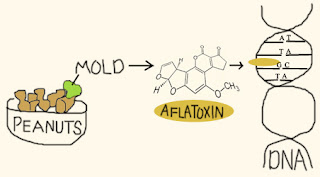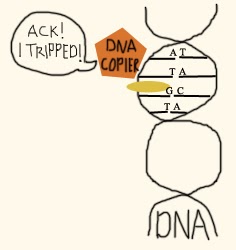First, let's introduce the co-stars of this production: B cell and mast cell. You may remember meeting B cell in our previous post, "Meet Your Immune System".
Now let's meet the villain, The Allergen (the thing to which you are allergic).
It all starts when B cell is just going for a stroll through your body, on patrol making sure everything is ok.
When all of a sudden, the B Cell encounters The Allergen (dun, dun, dun). This sends the B Cell into high alert: he calls for his friends and starts whipping out boomerangs ("antibodies") to wrangle The Allergen.
Mast cell wanders by and grabs hold of some of these boomerangs ("antibodies"). You see, mast cells have special hands that are designed only to grab antibodies. These hands are called "Fc Receptors", because you really wanted to know that.
When mast cell's hands grab these antibodies, that sends him into high alert as well, and he begins producing tons of a chemical called "histamine".
"Histamine! I've heard of that: I take anti-histamines to block that! Bad, bad, bad!" you say. Well, actually, histamine has the very important job of making your blood vessels bigger so that other superhero immune cells can come to the site of the action and get rid of the villain, The Allergen.
This biggering and biggering makes you swell up or get itchy bumps, and this is pretty uncomfortable and you don't like it, so that's why you think histamines are bad. And actually, sometimes this swelling can get out of control and make your airway close up and blood pressure drop since there's more room for blood to pool elsewhere ("anaphylaxis")-- so, sometimes it is indeed dangerous and requires medication.
Wait! So many questions!
"Why does my body think an allergen is bad in the first place? Why does the immune system treat it like a bacteria or a virus?"
When you're infected with bacteria or a virus, there are conserved signals that your immune system sees. In other words, most pathogens have similar codes / elements that signal danger to the immune system-- codes that are conserved and haven't changed over time. So our bodies have evolved to see these as dangerous. All of us. But if we intake something that doesn't have the conserved "danger signal" (like food), then our immune systems don't react against it like an invader.
But some people's bodies see non-invaders as a threat. Why? That's an area that's under active study. One possibility is that some people have immune cells that were activated by a pathogen but also cross-react with the allergen. In other words, the allergen looks a little like an invader that the person's immune system once saw, so the immune cells see it as related and mount an attack. This would also explain why some allergies (like those to pollen) generally don't start until ages 5 years old and up. Another possibility is that allergic people have increased sensitivity to weaker stimuli. (Related follow-up posts to come: immune tolerance, and diversity).
"Do I have to worry about anaphylaxis with all allergies?"
Anaphylaxis is usually only associated with allergens that you eat or that are injected into you: foods, insect stings, and medicines. Allergens that you breathe in or that touch your skin (like pollen) don't usually trigger anaphylaxis (but inhaled allergens can trigger asthma attacks... for a future post!).
"How do the common treatments for allergies work?"
Exhibit A: Anti-histamines. These block the "histamine" secreted by mast cells, depicted above!
Exhibit B: Steroids (oral, topical, or inhaled). Picture yourself eating lots of little stop signs. They tell immune cells to stop, stop, stop.
Exhibit C: Allergy shots. Sometimes you don't even need a shot; you get it in a little tablet to dissolve under your tongue. The idea here is that you're giving your body a very low dose of the allergen, so low that it doesn't trigger a big response. Dendritic cells (introduced in Meet Your Immune System) gobble up the allergen and then send signals that help make Regulatory T cells (also introduced in Meet Your Immune System). The more you do this, the more Regulatory T cells you make. This might warrant a future in-depth post itself, because there are some other interest aspects of allergy shots, and you can read all about this in a scientific article if you want.
"Well, my mouth just gets a little itchy when I eat [thing to which you're allergic]. It's ok for me to keep eating it, right?"
Nooooo, don't do it! Just because anaphylaxis didn't happen to you the first time, or the first 10 times, or the first 30 times doesn't mean that it won't happen. I've heard a lot of stories from folks who were surprised on their 10th or 30th exposure by anaphylaxis. Heed the warning signs.
"Are allergies more common these days than they used to be?"
We don't know for sure. What we know is that some medical institutions are reporting seeing more cases of allergies. Several possible explanations have been proposed:
Possible explanations, where there aren't actually higher rates of allergies (it just seems like it):
1. We're just detecting and reporting allergy cases better
2. Hospital closures funneling more people to fewer hospitals
Possible explanations, where there are more cases of allergies:
3. Environmental changes are skewing the immune system (stay tuned for a post related to the topic of environment influencing the immune system!)
4. Delays or increases in exposing children to nuts from an early age (this is a controversial topic, but there is no conclusive evidence either way right now-- only correlations)
"Why are some people more prone to allergies than others?"
The short answer here is: 1) Different people have different immunological "environments" or "balances" that favor or disfavor certain diseases, and 2) Different people have different sensitivity and responsiveness of their immune cells based on their genes (and this is why the "allergic phenotype" runs in families). Stay tuned for a whooooole other illustrate post on this with some really interest historical anecdotes.
If you've learned from this and want to share with others, consider my new illustrated immunology book!















